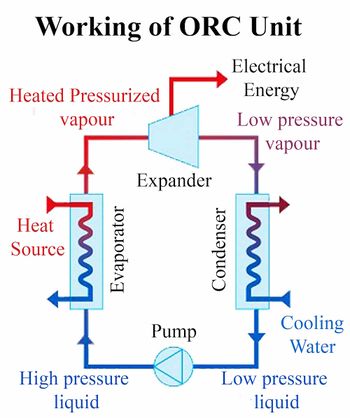Organic Rankine cycle

The organic Rankine cycle is is similar to the Rankine steam cycle, but uses an organic fluid such as refrigerants and hydrocarbons instead of water as the working fluid.[2] The ordinary Rankine cycle uses thermal power to convert water to steam, which expands through a turbine in order to generate electricity. The organic Rankine cycle operates in the same way, however instead of using water, which has a relatively high boiling point (100°C), the organic Rankine cycle uses an organic fluid that has a much lower boiling point than water.[3] An ideal fluid for this should have a low boiling point so it will vaporize (become a gas) at lower temperatures, along with a low freezing point so it will never become solid throughout the cycle. Compounds of butane or pentane satisfy these requirements and are commonly used.
Organic Rankine cycle (ORC) machines are used to convert low-temperature heat resources into power. Examples include systems making use of waste heat in a cogeneration system, low temperature geothermal electricity generation, solar ponds, and potentially OTEC.[2]
For Further Reading
References
- ↑ Avinash Shaligram. "Improving Efficiency of ORC Power Generation," Tech Briefs Media Group, 2016. [Online]. Available: https://contest.techbriefs.com/2016/entries/sustainable-technologies/6990
- ↑ 2.0 2.1 Tchanche, Bertrand F, Lambrinos, Gr, Frangoudakis, A, & Papadakis, G. (2011). Low-grade heat conversion into power using organic Rankine cycles – A review of various applications. Renewable & Sustainable Energy Reviews, 15(8), 3963–3979. https://doi.org/10.1016/j.rser.2011.07.024
- ↑ Ormat. (August 12, 2015). Organic Rankine Cycle [Online], Available: http://www.ormat.com/organic-rankine-cycle

